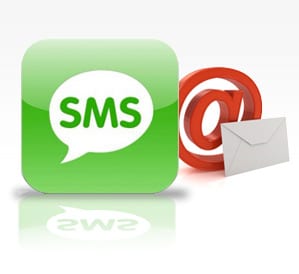It’s quick, cheap, personal, high impact: Are you taking full advantage of SMS?
 SMS is immediate and easy for senders and recipients - making it an ideal communication tool to build loyalty and acquire new customers quickly and cheaply.
SMS is immediate and easy for senders and recipients - making it an ideal communication tool to build loyalty and acquire new customers quickly and cheaply.
Disappointingly, the 2012 Adestra and Econsultancy Email Marketing Industry Census found only 13% of those surveyed combined email and SMS to deliver their marketing messages - what a missed opportunity!
SMS communication leverages mobile phone ubiquity
How far away is your mobile phone from you right now? My guess is it’s going to be close by; either on the desk next to you or in your handbag or pocket.
How often do you check your phone? As soon as you hear it, every half an hour or so, or every hour; depending on what you are doing?
Do you ever go anywhere without your mobile? If you forget it and leave it at home, do you feel lost?
If you answered "Yes"to these questions, you are not alone. 70% of UK adults own at least one mobile phone, and 99% of mobiles can send and receive SMS.
People take their mobile phones everywhere, so SMS communication has the potential to connect you to customers and prospects regardless of location. SMS reach is unrivalled by nearly any other marketing communication tool. And, most mobile phone users already know how to send SMS; so they don’t need to learn a new technique or download software to respond to your messages.
Four great ways to integrate mobile SMS in your marketing campaigns
1. Text to encourage email registration
SMS is a great way to encourage people to sign up to receive your email communications, even when they aren’t near a computer.
Why not include an SMS response option in your print, radio and event communications?
SMS offers a much more efficient alternative to manually recording email addresses using a clip board at an event. SMS allows people to respond to your communications immediately. If people provide you with their email address there and then, you can send them an email to await their return to the office; a timely reminder of their sign up and who you are.
An instant communication is far better than a respondent having to wait weeks to receive your email following a relatively lengthy clipboard-to-computer transcription process. A manual process also injects an element of risk into data collection. You may not be able to read a high proportion of ‘clipboard’ addresses – and there is a danger the time delay will cause new enquirers to forget who you are, or find an alternative supplier.
SMS is an immediate, effortless and accurate alternative to other acquisition campaign response mechanisms.
To see how effective SMS is, just text the word ‘subscribe’ and your email address to 81222 to sign up to Adestra’s email newsletter.
2. Outbound reminders and confirmations
SMS is perfect for event reminders, purchase confirmations and change notifications.
Send an SMS text message to everyone who has pre-registered for an event on the morning it occurs to remind them about the event and deliver relevant information to improve their event experience.
When one of my colleagues worked client-side, he attended a show with 22,000 attendees over three days. Entry to the show was via eight registration desks and 16 self-service touch screens. The touch screens allowed people to collect their badges, provided they had their URN number with them! Of course, no one had remembered their URN number, so thousands of people formed long queues at the desks, becoming increasingly annoyed and blaming the organisers.
At the next show, all pre-registrants received a SMS containing their URN on the morning of the show. The SMS reduced average queuing time to five minutes, dramatically improving the customer experience. In addition, the second half of the message was sponsored for a five figure sum, creating an innovative new revenue stream for the show organisers.
3.Unsubscribed or bounced from email
SMS offers a useful alternative way to contact subscribers who have been unresponsive to email. If your email communications are being bounced, and the recipient has opted-in to receive SMS communications, you can request an up-to-date email address via SMS.
Or, if someone unsubscribes from your email communications you can ask them if they would prefer to receive SMS communications instead.
4.Inbound charity SMS donations
Companies can monetise their SMS campaigns; for example, charities use SMS to request donations. A charity can pre-set a donation amount and ask people to text a keyword to a shortcode number to donate that amount. This simple approach takes the donor a matter of seconds. If someone wants to donate more than the pre-set amount they can simply text more than once.
An SMS response mechanism is easy to integrate with offline marketing communications. And, best of all, this approach is budget friendly - a SMS call-to-action is easy to add to existing campaign communications.
A couple of key points re: SMS communication planning
It’s important to make sure it’s clear what you want to use someone’s mobile number for at the data collection point. Mobile is such a personal intrusive medium that people are going to respond negatively to unwanted SMSs.
Also, when sending outbound campaigns, ensure you know what time zone the message recipients are in. No matter how fascinating your message, people are unlikely to appreciate it in the middle of the night.

With thanks to
Henry Hyder-Smith for sharing his advice and opinions in this post. Henry is Managing Director and Co-Founder of Adestra Ltd . You can follow him on
Twitter or connect on
LinkedIn.



 With thanks to
With thanks to 

